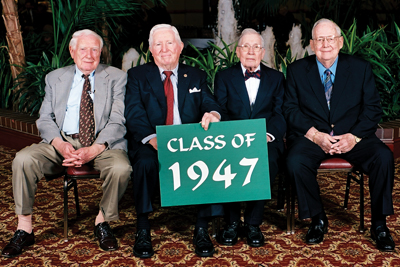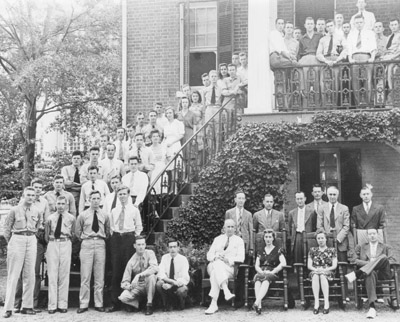Frank Waldo, M.D.
By Kathy Seale
 |
Frank Waldo (second from right) with classmates (left to right) Theo Kirkland, Mervel Parker, and Wyatt Haisten at the 2011 Medical Alumni Weekend |
In 1945, when the Medical College of Alabama moved from Tuscaloosa to Birmingham, second-year student Frank Waldo moved with it. He calls the 40 members of his class “privileged witnesses” to the metamorphosis of a fledgling medical center into the sprawling institution known as UAB. “We consider ourselves pioneers,” he says.
Twelve of the trailblazers in that class—the second to graduate from the Birmingham-based school—survive, says Waldo, who practiced pediatrics in Homewood for 35 years and was associate medical director of Children’s Hospital for 13 years. And those members remain close.
In fact, Waldo saw them in February at the class of 1947’s 64-year reunion, which he chaired. It was his sixth time in that role, and he looks forward to a seventh chairmanship in 2012. “That will be quite an accomplishment,” he says with a smile. “I’ll be 90 this June.”
Oklahoma to Alabama
As a child growing up in El Reno, Oklahoma, Waldo never expected to attend medical school in Alabama, or to settle in Birmingham for the long haul, he says. His journey began with a stint in the Navy after three years at the University of Central Oklahoma in Edmond.
“They did not defer pre-medical students at that time,” says Waldo, who was stationed in San Diego, Calif., and served at the Naval Medical Center. He finished his degree at the University of the Pacific in Stockton.
In 1943, Waldo was selected for the medical school in Tuscaloosa. “The class of 1947 was the last class to study the basic medical sciences on the Tuscaloosa campus,” he explains. While there, Waldo met his future wife, now deceased, a University of Alabama student from Homewood, Ala., named Betty Jo Bryson.
When the medical school moved to Birmingham, students attended classes on three floors of Jefferson Hospital, which housed the newly created medical center along with Hillman Hospital. Some of the faculty volunteered their teaching time, Waldo recalls.
After graduation, Waldo interned at the University of Wisconsin Hospital in Madison and returned to Birmingham for his residency. Later he, too, volunteered to teach part-time at the new medical center. “Everybody was gung ho,” Waldo remembers. “There was excitement, something new. People wanted to be involved.”
Witness to Medical History
In 1949, Waldo would leave Birmingham once more, when he volunteered for two more years of service in the Navy. When he returned, he practiced pediatrics. “I never had a single day I dreaded going to work,” he says.
In the following decades, Waldo witnessed monumental changes in medicine as well as the evolution of his alma mater. After training for polio care at Harvard Medical School and working with polio patients during his residency and practice, he found the development of the polio vaccine to be a particularly meaningful breakthrough. “The worries of getting polio dropped to near zero,” he says. “It was a tremendous experience, not only for physicians but also for the whole country.”
Other vaccines changed lives, as did new therapeutic and diagnostic techniques such as CT scans and minimally invasive surgery. These innovations improved the care of generations of children in the Birmingham area, Waldo says.
Active Alumnus
Today, Waldo leaves medical care to members of the younger generation, including his son. Bryson Waldo, M.D., is a 1978 graduate of the UAB School of Medicine and was a professor of pediatric nephrology at UAB for 15 years before entering private practice as a pediatrician.
The senior Waldo, who lives in Homewood, doesn’t visit the UAB campus much anymore, except for the coffee concerts of the Alabama Symphony Orchestra at the Alys Robinson Stephens Performing Arts Center. But he remains active in the Medical Alumni Association, and he is deeply proud of the medical center and university that now encompasses more than 80 city blocks.
“When you come right down to it, what would Birmingham and Alabama be without it?” Waldo says.
 |
Waldo (second from left on the front row) with the Gorgas Society in Tuscaloosa, circa 1945-1946 |